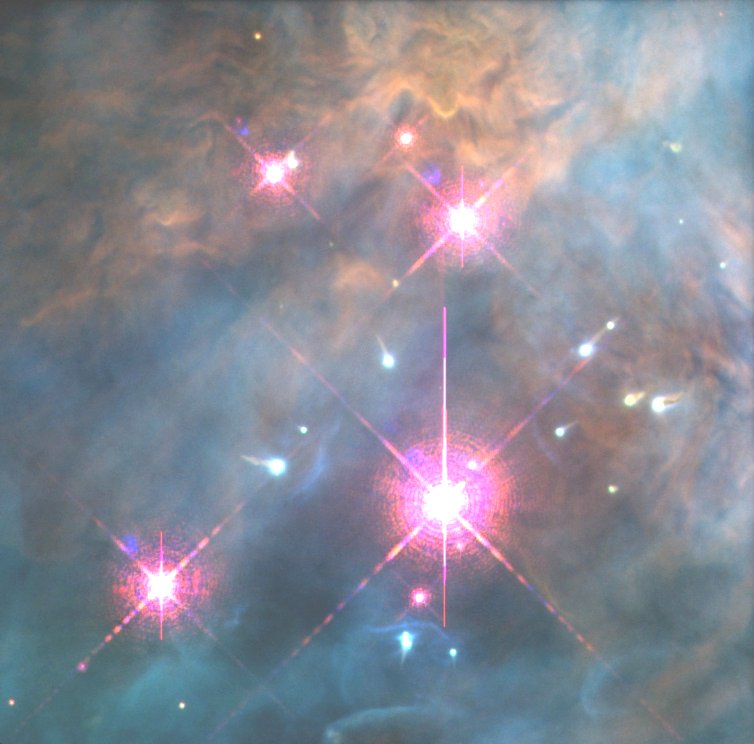

The Orion Trapezium and their (artificial) .................................. The Trapezium from Earth
Airy-disks, January 14, 1997; (c) AURA / STScI

Hubble Space Telescope deployed by Space Shuttle Endeavor after its STS-61 crew had finished the first servicing mission, December 13, 1993; (c) AURA / STScI


The Orion Trapezium and their (artificial) ..................................
The Trapezium from Earth
Airy-disks, January 14, 1997; (c)
AURA / STScI
There are very few planet images here. That's because Hubble is designed to peek into the deep universe and only occasionally looks around in the neighborhood. Furthermore, numerous spacecraft have gone to the planets and were able to take close-up shots which are necessarily better than what Hubble can do from its Earth orbit. For planet images check web sites for images from the spacecraft Mariner, Venera, Pinoeer, Viking, Surveyor, Pathfinder, Voyager, Galileo, and Cassini.
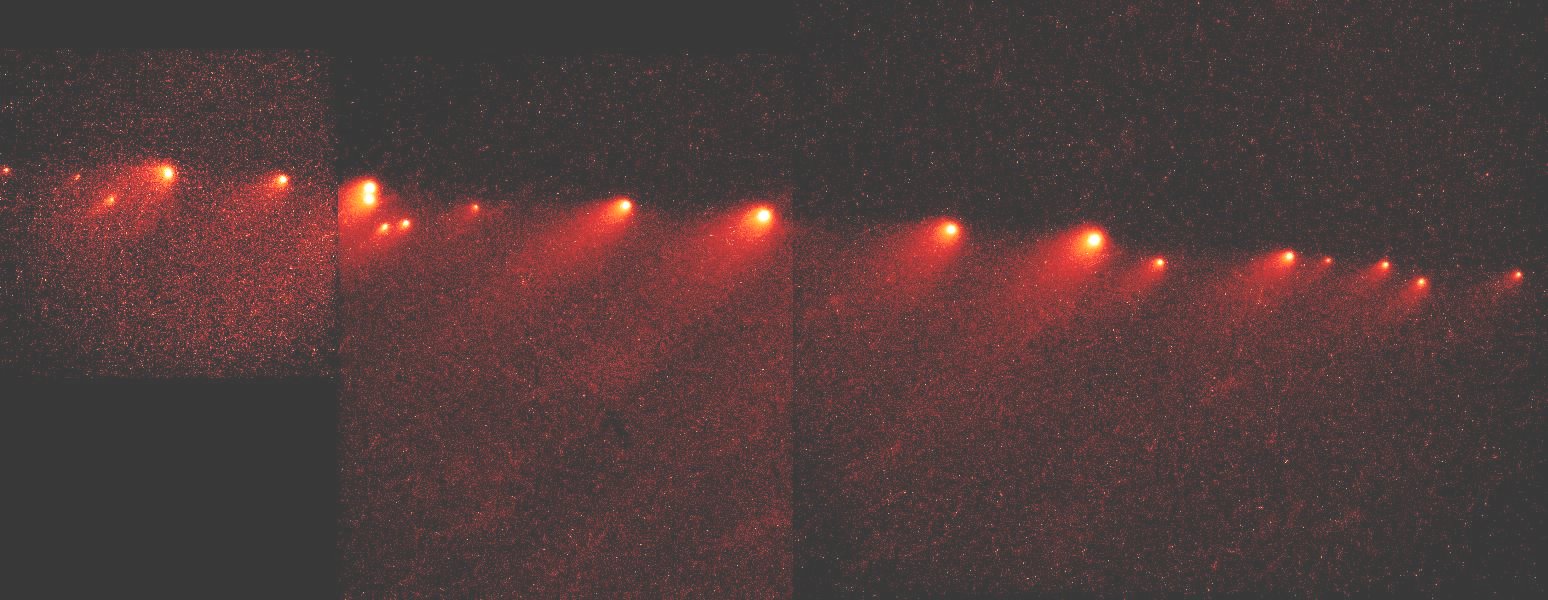
Comet Shoemaker-Levy 9 (1993e), June 14, 1995; (c)
AURA / STScI

Comet Shoemaker-Levy 9 impact sites on Jupiter, July 27, 1994; (c)
AURA / STScI
A gallery
of impact images featuring Hubbel, Keck, Lick, IRTF and others.

Aurora on Saturn, January 7, 1998; (c)
AURA / STScI
"Saturn's north and south poles display spectacular oval-shaped curtains
of light, called auroras, which were captured in ultraviolet light by Hubble's
Space Telescope Imaging Spectrograph (STIS)."
An early image (shortly after Charon's ....................... best
image from Earth
1978 discovery by James Christy)




Hubble Space Telescope - before ............... Hubble Space Telescope,
adjustment of focus, 1993 ........................... June 14, 1995;
(c)
AURA / STScI
This is an excellent example for HST's superior performance above (almost)
all ground-based telescopes (but see Keck
(on Hawaii) and VLT (in
Chile) images). Compare the early image of Pluto and Charon, the best
image taken from Earth, the pre-Costar image from HST and HST's best image
with each other.
Size is not important for the first two or three images: they just
appear so big because Pluto and Charon are completely blurred! And that
is HST's advantage: it makes very sharp images.
In that case, do we still need telescopes on Earth? Yes. For one
thing, the hundreds of professional telescopes in the world can work at
hundreds of research projects at the same time - naturally. Hubble can
do only one at a time, and these observations are so sophisticated that
they take more time than with a comparable ground-based telescope. Also,
Hubble avoids a circle of 50 degrees around the Sun, so it's optics won't
get damaged. Therefore we need other telescope that can observe objects
closer to the Sun.
Stars

Sagittarius Star Cloud, ; Hubble heritage Team, (c)
AURA / STScI

Eagle Nebula, November 9, 1995; (c)
AURA / STScI
"Towers of sculpted gas in the Eagle nebula (M16) are actually cocoons
for embryonic stars."
Add: Orion Nebula mosaic

Destruction of Circumstellar Disks In Orion's Trapezium, January 14,
1997; (c) AURA / STScI

"Proplyds" in Orion Nebula, June 14, 1995; (c)
AURA / STScI


Looking Down a Barrel of Gas at a Doomed Star, January 6, 1999; .........................
M57 Ring Nebula from Earth,
Hubble Heritage Team, (c) AURA / STScI
...............................................................(c) H.-M.
Reble
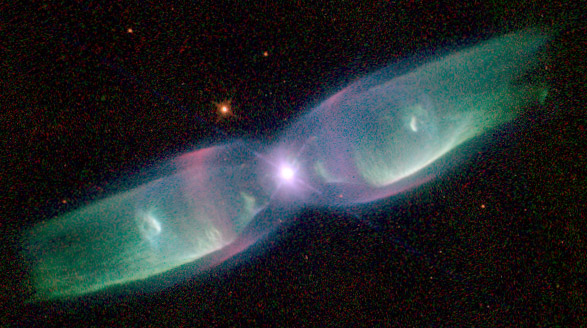
Butterfly or Twin-Jet Nebula, December 17, 1997; (c)
AURA / STScI
"The dying star M2-9 is nicknamed the Twin Jet nebula because the two
tubes of gas streaming from it behave like exhaust from a jet engine."

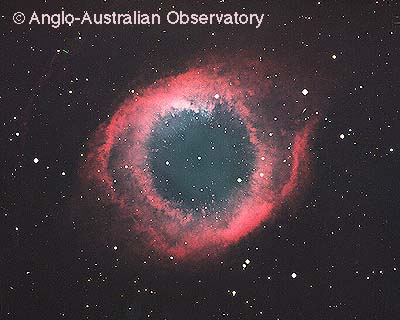
Helix Nebula, April 15, 1996 ..............................................................Helix
Nebula from Earth
(c) AURA / STScI
The Hubble image on the left enhances a small portion of the lower
left inside part of the Helix's ring on the right. The (so-dubbed)
"cometary knots" (just a name - has nothing to do with comets,
except the way they look) are produced by stellar wind from the
white dwarf that is rushing into the planetary nebula (ejected 10,000 years
ago from the white dwarf).

Stingray Nebula, April 2, 1998; (c)
AURA / STScI

Egg nebula, dying star, May 12, 1997; (c) AURA / STScI
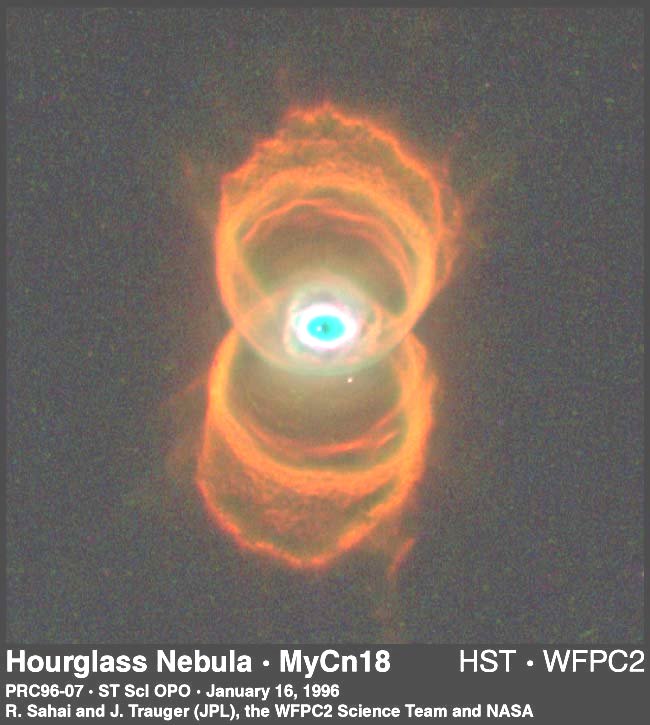
Hourglass Nebula, January 16, 1996; (c) AURA / STScI
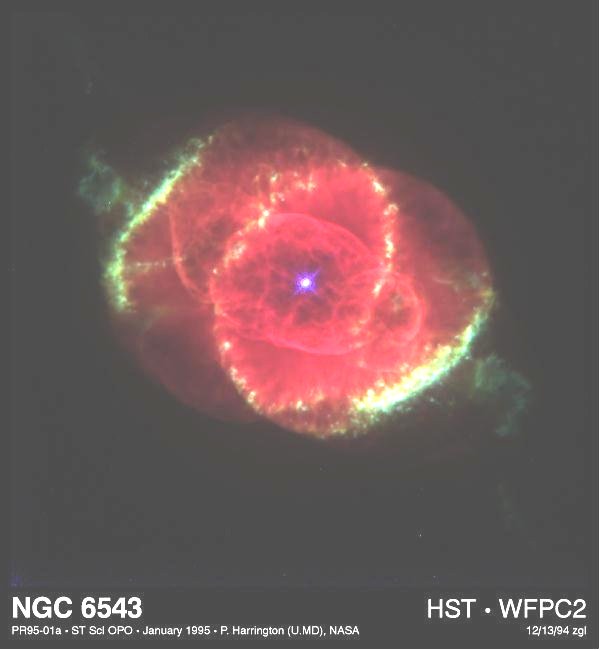
Planetary Nebula NGC 6543 (Cateye nebula), June 29, 1995; (c)
AURA / STScI
"Rings of gas surround the dying star NGC 6543, nicknamed the Cat's
Eye."
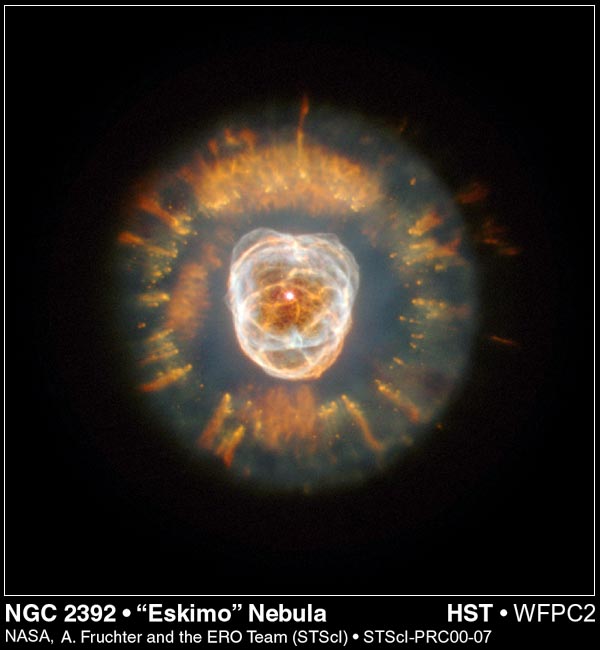
And still another planetary nebula, January 24, 2000; (c)
AURA / STScI.

Eta Carinae, June 10, 1996; (c) AURA
/ STScI
"A pair of billowing dust and gas clouds have been cast off by the
massive dying star Eta Carinae."

Supernova 1987A, May 19, 1994; (c)
AURA / STScI
"A large pair of gaseous rings frame a glowing halo of gas surrounding
the massive dying star Supernova 1987A."

SN1987A in the Large Magellanic Cloud, February 4,1999; (c) Hubble Heritage Team, (c) AURA / STScI

Cygnus Loop, June 14, 1995; (c) AURA
/ STScI


Heart of M15, Globular Cluster in Pegasus, ............................................................
Heart of M15 from Earth
November 8, 1995; (c) AURA / STScI

Cartwheel Galaxy, November 26, 1996; (c)
AURA / STScI

Hubble Reveals Stellar Fireworks Accompanying Galaxy Collisions (Antennae
galaxies), October 21, 1997, (c) Brad Whitmore; (c)
AURA / STScI
"A collision between two spiral galaxies has spawned brilliant bursts
of star birth."

Hubble Provides Multiple Views of How to Feed a Black Hole (center of
Centaurus A galaxy), May 14, 1998, E.J. Schreier; (c)
AURA / STScI
"Astronomers have used NASA's Hubble Space Telescope to probe the core
of the nearest active galaxy to Earth, Centaurus A. [...] The disk
feeds material to presumably an inner, unresolved accretion disk that is
made up of gas entrapped by the black hole."

STIS Records A Black Hole's Signature, May 12, 1997, Gary Bower, Richard
Green (NOAO), the STIS Instrument Definition Team; (c)
AURA / STScI
'The colorful "zigzag" on the right is not the work of a flamboyant
artist, but the signature of a supermassive black hole in the
center of galaxy M84, discovered by Hubble Space Telescope's Space
Telescope Imaging Spectrograph (STIS)."

Black Hole in the galaxy NGC 4261 (in Virgo), December 4, 1995; (c)
AURA / STScI
"A spiral-shaped disk of dust is feeding a massive black hole in the
galaxy, NGC 4261." The black hole is estimated to have 1.2 billion
sun masses. Press
release right here.

Gravitational Lens, April 24, 1996; (c) AURA / STScI

Hubble Deep Field, January 15, 1996; (c)
AURA
/ STScI
"Hubble peers back more than 10 billion years to reveal at least 1,500
galaxies at various stages of development."
The Trapezium from Earth; courtesy of Sproul
Observatory at Swarthmore College
Charon Discovery Photo; courtesy of Canada-France-Hawaii
Telescope Corp.
Pluto and Charon; courtesy of Nordic
Optical Telescope
Helix Nebula from Earth; courtesy of Anglo-Autralian
Observatory, photo by David Malin
Heart of M15 from Earth; courtesy of Melton
Memorial Observatory
All other Photos are courtesy AURA / STScI . For credits see here.

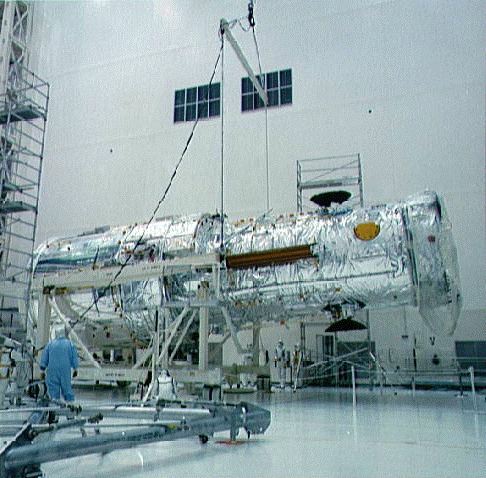
There are more than 50 telescopes in the world that are larger than HST: they gather more light, i.e. quicker. HST can easily make up for its lower ability of gathering light because it can operate 24 hours a "day" since ...
So what makes it a superior telescope?
Cometary Globule CG4, from the Anglo - Autralian Telescope, by David Malin:

My favorite VLT images
